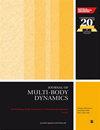Cab-Over-Engine truck cabins: A mathematical model for dynamics, driver comfort, and suspension analysis and control
IF 1.9
4区 工程技术
Q3 ENGINEERING, MECHANICAL
Proceedings of the Institution of Mechanical Engineers Part K-Journal of Multi-Body Dynamics
Pub Date : 2022-12-04
DOI:10.1177/14644193221141596
引用次数: 2
Abstract
Various cabin designs have been developed for commercial vehicles to meet different driver comfort requirements. Among those configurations, the cab-over-engine (COE) is widely used because of its compact size and good road visibility. Since the engine is assembled underneath the cabin, it is required that the cabin can be entirely tilted forward in order to access the engine for inspection and maintenance. Hence, the forepart of the cabin suspension is designed to connect with the chassis frame through a linkage mechanism. The dynamic modelling of this commonly used configuration was lack of study in the literature, but it is essential for further cabin's dynamic analysis and vibration control. Considering the rapid development of the comfort-oriented cabin suspension, this study introduces a multi-body dynamic modelling approach for the COE cabin with a titling mechanism. The dynamic equations are derived based on the Lagrangian modelling method, which are then implemented in MATLAB/Simulink. Besides, a high-fidelity truck model is developed in ADAMS/Car to study the accuracy of the proposed dynamic model through co-simulation. Meanwhile, a four-point cabin model that has been widely used in past studies is used as the benchmark. The simulation results demonstrate that the proposed cabin dynamic model can accurately estimate the cabin's behaviour in vertical, roll, and pitch directions, which can be used for cabin dynamics, ride comfort, and cabin suspension control studies.驾驶室高于发动机的卡车驾驶室:动力学、驾驶员舒适度和悬架分析与控制的数学模型
商用车的客舱设计多种多样,以满足不同驾驶员的舒适性要求。在这些配置中,驾驶室-发动机(COE)由于其紧凑的尺寸和良好的道路能见度而被广泛使用。由于发动机是在机舱下方组装的,因此要求机舱可以完全向前倾斜,以便对发动机进行检查和维护。因此,将座舱悬架前部设计为通过连杆机构与底盘框架连接。这种常用结构的动力学建模在文献中缺乏研究,但对进一步的座舱动力学分析和振动控制至关重要。针对以舒适性为导向的客舱悬挂系统的快速发展,本文提出了一种带有悬吊机构的COE客舱多体动力学建模方法。基于拉格朗日建模方法推导了动力学方程,并在MATLAB/Simulink中实现。此外,在ADAMS/Car中建立了高保真卡车模型,通过联合仿真研究了所提动力学模型的准确性。同时,采用以往研究中广泛使用的四点座舱模型作为基准。仿真结果表明,所提出的座舱动力学模型能够准确地估计座舱在垂直、横摇和俯仰方向上的行为,可用于座舱动力学、乘坐舒适性和座舱悬架控制的研究。
本文章由计算机程序翻译,如有差异,请以英文原文为准。
求助全文
约1分钟内获得全文
求助全文
来源期刊

CiteScore
4.10
自引率
11.10%
发文量
38
审稿时长
>12 weeks
期刊介绍:
The Journal of Multi-body Dynamics is a multi-disciplinary forum covering all aspects of mechanical design and dynamic analysis of multi-body systems. It is essential reading for academic and industrial research and development departments active in the mechanical design, monitoring and dynamic analysis of multi-body systems.
 求助内容:
求助内容: 应助结果提醒方式:
应助结果提醒方式:


